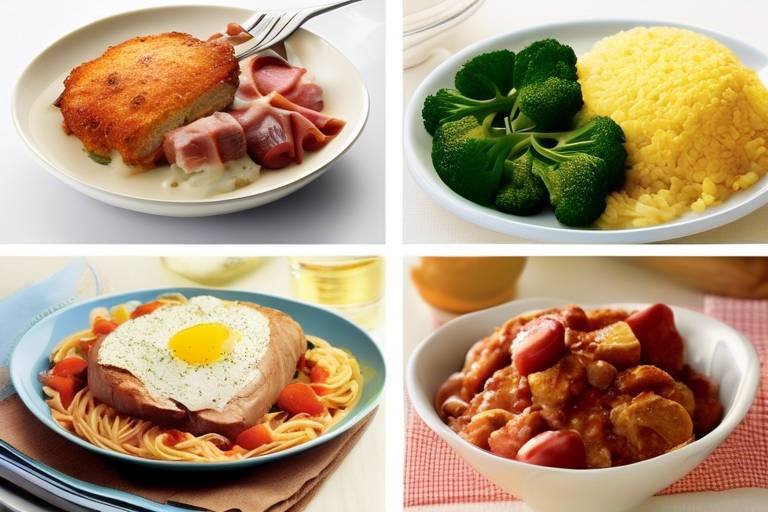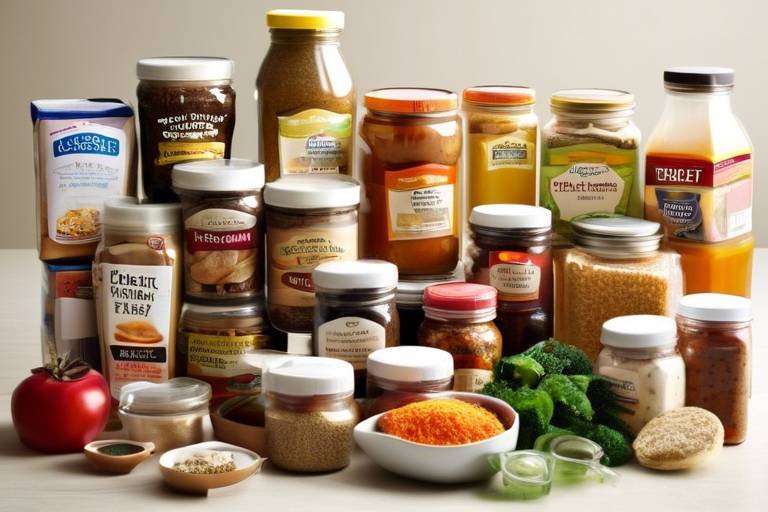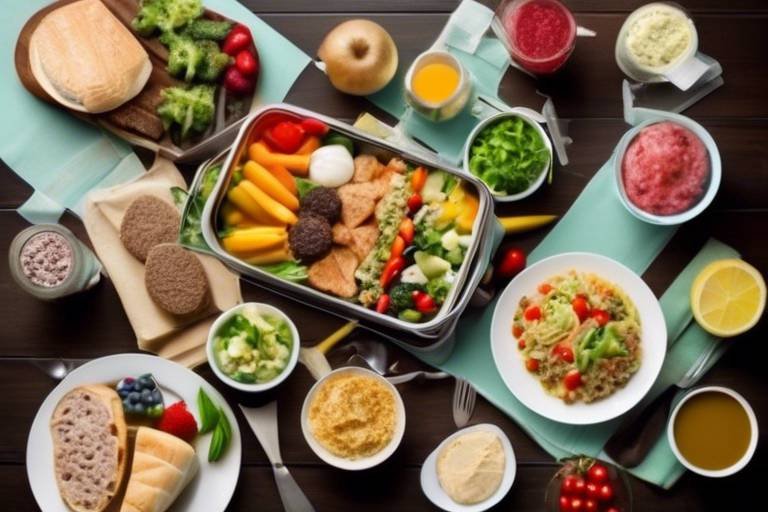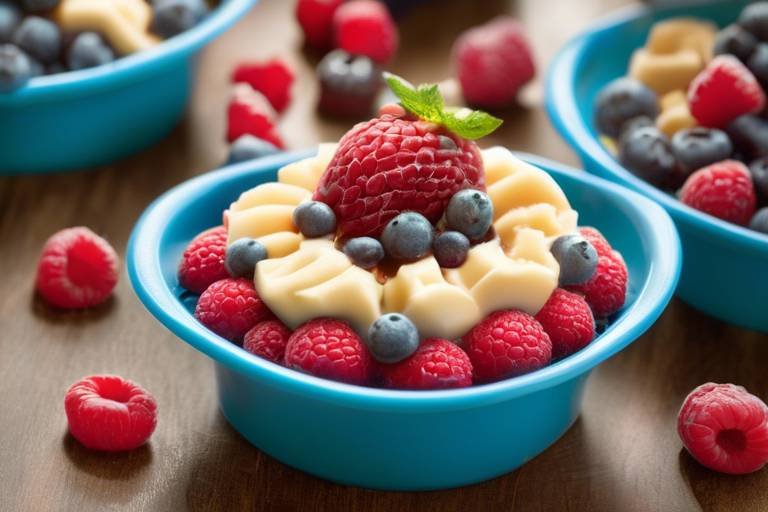How to Make Healthy Meals Quick and Easy
In today's fast-paced world, many of us find ourselves juggling work, family, and social commitments, leaving little time for meal preparation. However, eating healthy shouldn't feel like a daunting task. With the right strategies and a sprinkle of creativity, you can whip up nutritious meals in no time. Imagine coming home after a long day and being able to prepare a delicious, healthy dinner in under 30 minutes. Sounds like a dream, right? Well, it’s entirely possible! This article will guide you through practical tips for meal planning, quick recipes, and ingredient swaps that will help you maintain healthy eating habits without sacrificing flavor or time.
First things first, let's talk about meal planning. Understanding the fundamentals of meal planning can save you both time and stress. Think of meal planning as your roadmap to success in the kitchen. It allows you to create a balanced meal plan that aligns with your nutritional goals while fitting seamlessly into your busy schedule. Start by dedicating a few minutes each week to outline your meals. This can involve:
- Choosing a variety of proteins, vegetables, and whole grains.
- Considering your schedule to determine which meals can be prepped in advance.
- Making a grocery list based on your plan to avoid last-minute unhealthy choices.
By having a clear plan, you can streamline your cooking process, reduce food waste, and make healthier choices effortlessly.
Now, let’s dive into some quick and nutritious recipes that prioritize health without sacrificing flavor. These meals can be prepared in under 30 minutes, making it easy to enjoy healthy food even on the busiest days. Whether you’re a culinary novice or a seasoned chef, these recipes are designed to be straightforward and satisfying.
One-pot meals are a fantastic option for quick cooking and easy cleanup. Picture this: you throw all your ingredients into a single pot, let them simmer, and voilà! You have a hearty meal without the mountain of dishes to wash afterward. Here’s a simple recipe to get you started:
Ingredients: - 1 cup quinoa - 2 cups vegetable broth - 1 can black beans, rinsed - 1 cup corn - 1 bell pepper, diced - Spices: cumin, chili powder, salt, and pepper to taste Instructions: 1. In a pot, combine quinoa and vegetable broth. Bring to a boil. 2. Add black beans, corn, bell pepper, and spices. 3. Reduce heat, cover, and simmer for 15 minutes. Fluff with a fork and serve!
Stir-frying is another quick cooking method that retains nutrients and flavor. It’s like a dance in your kitchen! You can combine a variety of vegetables, proteins, and sauces for a satisfying meal that can be made in minutes. Just toss your ingredients in a hot pan with a splash of oil, and watch the magic happen!
For those who love simplicity, sheet pan dinners are a game-changer. You can layer ingredients on a single pan, roast them in the oven, and have a complete meal ready in no time. The best part? You can customize it to your taste! Just choose your favorite protein, add some colorful veggies, season with herbs and spices, and let the oven do the work.
Snacking can be healthy and satisfying. Instead of reaching for chips or candy, consider these quick snack ideas that are nutritious and easy to prepare:
- Greek yogurt with honey and berries.
- Veggies and hummus.
- Apple slices with almond butter.
These snacks will help you maintain energy levels throughout the day without compromising on health.
Making simple ingredient swaps can enhance the nutritional value of your meals. For example, try using whole grains instead of refined grains. Whole grains are packed with fiber and nutrients, making them a healthier choice. Incorporating options like quinoa, brown rice, or whole wheat pasta can make a significant difference in your diet.
Understanding the difference between whole and refined grains is crucial for healthy eating. Whole grains contain the entire grain kernel, which means they are rich in fiber, vitamins, and minerals. On the other hand, refined grains have been processed to remove the bran and germ, stripping away many nutrients. Make a conscious effort to choose whole grains whenever possible!
Choosing lean proteins can significantly impact your meal's healthiness. Incorporate options like chicken breast, turkey, fish, beans, and legumes into your diet. These proteins are not only lower in fat but also help with muscle maintenance and overall well-being. Think of protein as the building blocks of your body—choosing the right ones can lead to better health outcomes.
Q: How can I make meal prep easier?
A: Start small by planning one or two meals a week. Gradually increase as you get comfortable. Use containers for portioning and store meals in the fridge or freezer for easy access.
Q: What are some quick breakfast ideas?
A: Overnight oats, smoothies, and yogurt parfaits are great options that can be prepared in advance and are both nutritious and delicious.
Q: How do I stay motivated to eat healthy?
A: Experiment with new recipes and ingredients, and keep your meals colorful and exciting. Involve friends or family in your cooking process for added fun!

Meal Planning Basics
Understanding the fundamentals of meal planning can be a game changer for anyone juggling a busy lifestyle. Imagine coming home after a long day, exhausted, and the last thing you want to do is figure out what to eat. By investing a little time in planning your meals, you can save precious minutes during the week and reduce the stress that often accompanies last-minute cooking decisions. So, how do you get started?
First, it’s essential to establish your nutritional goals. Are you focusing on weight loss, muscle gain, or simply trying to eat more whole foods? Knowing your objectives will guide your choices and help you create a balanced meal plan. A good rule of thumb is to aim for a variety of food groups in each meal, including:
- Fruits and Vegetables: Aim for a colorful plate; the more colors, the more nutrients!
- Proteins: Incorporate lean meats, legumes, and dairy to keep you full.
- Whole Grains: Choose brown rice, quinoa, or whole grain bread for added fiber.
- Healthy Fats: Don’t shy away from avocados, nuts, and olive oil.
Next, consider your schedule. Do you have busy weekdays but more free time on weekends? Use this to your advantage by prepping meals ahead of time. You can cook in bulk, portion out your meals, and store them in the fridge or freezer. This way, you’ll have healthy options ready to grab when you’re rushing out the door or too tired to cook.
Another crucial aspect of meal planning is creating a shopping list. After deciding what meals you'll prepare, jot down the ingredients you’ll need. This list not only helps you stay organized but also prevents impulse buys at the grocery store. Stick to your list, and you’ll find that shopping becomes a breeze!
Lastly, don’t forget to be flexible. Life happens, and sometimes you might not feel like eating what you had planned. That’s okay! Keep a few easy-to-prepare meals in your back pocket for those days when plans change. It’s all about balance and making your meal planning work for you.
In summary, meal planning is about setting goals, understanding your schedule, creating a shopping list, and being adaptable. By following these basics, you’ll not only save time but also ensure that you’re nourishing your body with the right foods. So, are you ready to dive into the world of meal planning?

Quick and Nutritious Recipes
In today's fast-paced world, finding the time to prepare nutritious meals can feel like a daunting task. But fear not! With a little creativity and some clever strategies, you can whip up delicious dishes in no time. Imagine coming home after a long day and being able to create a meal that not only satisfies your hunger but also fuels your body with the nutrients it craves. Let’s dive into some quick and nutritious recipes that can be prepared in under 30 minutes, ensuring you never have to compromise on health or flavor.
First up, we have the delightful world of one-pot meals. These are a lifesaver for busy individuals. Picture this: you throw a bunch of ingredients into one pot, let them simmer, and voilà! You've got a hearty meal with minimal cleanup. One popular option is a chicken and vegetable stir-fry. Simply sauté some lean chicken breast with your favorite vegetables, add a splash of soy sauce, and serve it over brown rice. It’s quick, easy, and packed with flavor!
One-pot meals are not just convenient; they also allow for a variety of flavors and textures to meld together beautifully. You can experiment with different ingredients based on what's in season or what you have in your pantry. For instance, a quinoa and black bean bowl can be made by cooking quinoa with black beans, corn, diced tomatoes, and spices. This dish is not only filling but also offers a complete protein source, making it a fantastic option for vegetarians.
Now, let’s talk about stir-fries. This method is not just quick; it’s also a wonderful way to retain the nutrients in your vegetables. You can use any combination of veggies you have on hand—think bell peppers, broccoli, and snap peas. Toss them in a hot pan with a little olive oil, add your choice of protein like shrimp or tofu, and finish with a drizzle of teriyaki sauce. In just minutes, you’ll have a colorful, vibrant meal that’s as pleasing to the eyes as it is to the palate.
If you prefer a hands-off approach, sheet pan dinners are the way to go. Just arrange your protein and veggies on a baking sheet, season them with your favorite herbs and spices, and let the oven do the work. For example, a salmon and asparagus sheet pan dinner is a breeze. Place salmon fillets on the pan, surround them with asparagus, drizzle with olive oil, and sprinkle with lemon juice. Bake until everything is cooked through, and you’ll have a meal that tastes gourmet without the fuss.
Don't forget about healthy snacks to keep your energy up throughout the day. Quick options like Greek yogurt with honey and berries, or hummus with carrot sticks can make a world of difference. These snacks are not only nutritious but also incredibly satisfying, helping you avoid those mid-afternoon energy slumps.
In summary, with a little planning and creativity, preparing quick and nutritious meals can become a delightful part of your routine. Whether you choose one-pot meals, stir-fries, or sheet pan dinners, the key is to keep it simple and enjoyable. So, roll up your sleeves and get cooking—you’ll be amazed at how easy it is to maintain a healthy lifestyle without sacrificing flavor or time!
Q: How can I make meal prep easier?
A: Start by planning your meals for the week ahead. Choose recipes that share ingredients to minimize waste and save time. You can also dedicate a few hours on the weekend to chop vegetables and marinate proteins, making weeknight cooking a breeze.
Q: What are some quick sources of protein?
A: Great options include canned beans, rotisserie chicken, eggs, Greek yogurt, and canned tuna. These can be added to salads, wraps, or eaten on their own for a quick protein boost.
Q: How can I ensure my meals are balanced?
A: Aim to include a source of protein, healthy fats, and plenty of colorful vegetables in each meal. This balance will help you stay full and satisfied while providing essential nutrients.

One-Pot Meals
One-pot meals are a game-changer for anyone juggling a busy lifestyle. Imagine coming home after a long day, and instead of facing a mountain of dishes and complicated recipes, you have just one pot to deal with. How amazing is that? The beauty of one-pot meals lies in their simplicity and efficiency. You can throw in a variety of ingredients, let them simmer together, and voilà! You've got a delicious, nutritious meal with minimal effort and cleanup.
These meals are not only convenient but also allow for a fantastic blend of flavors. When all the ingredients cook together, they create a harmonious dish that’s bursting with taste. Whether you’re in the mood for a hearty stew, a comforting pasta, or a vibrant vegetable dish, there’s a one-pot recipe out there for you. Plus, you can customize them based on what you have in your pantry, making them perfect for using up leftovers and reducing food waste.
Here’s a quick overview of how to create a basic one-pot meal:
- Choose a Base: Start with a grain or a protein as your base. This could be rice, quinoa, or even pasta.
- Add Vegetables: Toss in a variety of vegetables. Fresh, frozen, or even canned options work well.
- Seasoning: Don’t forget the spices! A good mix of herbs and spices can elevate your dish.
- Liquid: Add a broth or sauce to bring everything together.
Here’s a simple recipe to get you started:
| Ingredients | Amount |
|---|---|
| Brown rice | 1 cup |
| Vegetable broth | 2 cups |
| Mixed vegetables (carrots, peas, bell peppers) | 2 cups |
| Olive oil | 2 tablespoons |
| Garlic (minced) | 2 cloves |
| Salt and pepper | To taste |
To prepare, simply heat the olive oil in your pot, sauté the garlic until fragrant, add the rice, pour in the vegetable broth, and bring it to a boil. Then, lower the heat, add the mixed vegetables, cover, and let it simmer until the rice is cooked. In just about 30 minutes, you’ll have a wholesome meal that’s sure to please.
One-pot meals are also incredibly versatile. You can easily swap out ingredients based on your dietary preferences or what’s in season. Want to make it vegan? Swap the broth for vegetable stock and add tofu for protein. Craving something heartier? Toss in some chicken or beans. The possibilities are endless!
So next time you’re short on time but still want to enjoy a healthy meal, remember that one-pot meals are your friend. They’re not just easy; they’re also a delightful way to bring together a variety of flavors and nutrients in a single dish. Why complicate things when you can keep it simple and delicious?
Q: Can I meal prep one-pot meals?
A: Absolutely! One-pot meals are perfect for meal prepping. You can make a large batch and store individual portions in the fridge or freezer for quick meals throughout the week.
Q: Are one-pot meals healthy?
A: Yes! By choosing wholesome ingredients like whole grains, lean proteins, and plenty of vegetables, you can create a nutritious one-pot meal that supports your health goals.
Q: How do I prevent my one-pot meals from becoming too mushy?
A: To avoid mushiness, be mindful of cooking times and the types of ingredients you use. For example, add quicker-cooking vegetables later in the cooking process or use a timer to ensure everything is cooked just right.

Stir-Fry Wonders
When it comes to quick and healthy cooking, stir-frying is a culinary superhero. This method is not only fast but also retains the vibrant colors and nutrients of the ingredients, making your meals both visually appealing and packed with goodness. Imagine tossing fresh vegetables and lean proteins together in a hot pan, with the sizzle of garlic and ginger filling the air—it's a feast for the senses!
Stir-frying is all about speed and efficiency. The key is to have all your ingredients prepped and ready to go before you even turn on the stove. Think of it like a dance; you need to know your steps before the music starts. Start by chopping your favorite vegetables—bell peppers, broccoli, and snap peas are fantastic choices. Add in some protein like chicken, tofu, or shrimp, and don’t forget to whip up a simple sauce using soy sauce, sesame oil, and a hint of honey for sweetness.
Here’s a quick guide to creating a stir-fry that will leave you feeling satisfied:
- Choose Your Base: Brown rice, quinoa, or whole grain noodles make great bases for your stir-fry.
- Pick Your Protein: Go for lean options like chicken breast, turkey, or plant-based proteins like tempeh.
- Load Up on Veggies: The more colorful, the better! Aim for a mix of textures and flavors.
- Add Flavor: Use garlic, ginger, and your favorite sauces to elevate the dish.
Now, let’s talk about the cooking process. Heat a tablespoon of oil in a large skillet or wok over high heat. Start with the protein, cooking it until it’s golden brown. Then, add the vegetables, beginning with the ones that take longer to cook, like carrots and broccoli, and finishing with quicker-cooking ones like bell peppers and leafy greens. Stir-fry everything for just a few minutes until the veggies are tender yet crisp. Finally, drizzle your sauce over the top, toss everything together, and voila! You have a delicious meal ready in under 30 minutes.
But what if you want to take it a step further? Here are some tips to elevate your stir-fry game:
- Experiment with Flavors: Try adding different sauces like teriyaki, oyster sauce, or even a splash of lime juice for a zesty kick.
- Garnish Wisely: A sprinkle of sesame seeds or chopped green onions can add a nice finishing touch.
- Make it a Meal Prep Star: Stir-fries store well in the fridge, so make a big batch and enjoy it throughout the week!
Stir-frying is not just about cooking; it's about creating a delightful experience in your kitchen. With a bit of practice, you’ll find yourself whipping up these delicious meals in no time. Plus, the versatility of stir-fry means you can easily customize it to fit your dietary needs or preferences. Whether you're a meat lover or a vegetarian, there's a stir-fry for everyone!
Q: Can I use frozen vegetables for stir-frying?
A: Absolutely! Frozen vegetables are a great time-saver and can be just as nutritious as fresh ones. Just make sure to thaw them slightly before adding them to the pan.
Q: What type of pan is best for stir-frying?
A: A wok is ideal for stir-frying because its shape allows for even cooking and easy tossing of ingredients. However, a large skillet will work just fine as well!
Q: How do I prevent my stir-fry from becoming soggy?
A: Make sure not to overcrowd the pan. Stir-fry in batches if necessary, and keep the heat high to ensure a nice sear without steaming the ingredients.
Q: Can I make a stir-fry ahead of time?
A: Yes! Stir-fries can be made ahead and stored in the fridge for a few days. Just reheat them on the stove or in the microwave before serving.

Sheet Pan Dinners
Sheet pan dinners are a game-changer for anyone looking to simplify their cooking routine while still enjoying delicious and nutritious meals. Imagine this: you come home after a long day, exhausted and hungry, and the last thing you want to do is spend hours in the kitchen. This is where sheet pan dinners swoop in to save the day! With just one pan, you can create a complete meal that is not only easy to prepare but also minimizes cleanup time. It’s like having a culinary superhero at your disposal!
To get started, all you need is a baking sheet and a few fresh ingredients. The beauty of sheet pan dinners lies in their versatility; you can mix and match your favorite proteins, vegetables, and seasonings to suit your taste buds. For example, you might choose to combine chicken breasts with colorful bell peppers, zucchini, and a drizzle of olive oil, seasoned with garlic and herbs. The result? A mouthwatering meal that roasts to perfection while you kick back and relax.
Here’s a quick breakdown of how to create your own sheet pan dinner:
- Choose Your Protein: Options like chicken, fish, or tofu work wonderfully.
- Select Your Veggies: Go for a variety of colors and textures—think broccoli, carrots, and cherry tomatoes.
- Add Flavor: Don’t forget to season! Use spices, herbs, and marinades to elevate your dish.
- Preheat Your Oven: Set it to around 400°F (200°C) for optimal roasting.
- Arrange on the Pan: Spread everything evenly on the sheet, ensuring some space between items for even cooking.
- Roast Away: Pop it in the oven for about 20-30 minutes, and voilà—dinner is served!
The key to a successful sheet pan dinner is to ensure that your ingredients have similar cooking times. This way, everything comes out perfectly cooked without any guesswork. And if you’re feeling adventurous, why not try adding some sweet potatoes or quinoa for an extra nutritional boost? You can even swap out proteins and veggies based on what you have in your fridge, making it a flexible option for any day of the week.
Not only are sheet pan dinners easy and quick, but they also encourage you to eat a variety of foods, which is essential for a balanced diet. Plus, they’re perfect for meal prepping—just make a larger batch and enjoy the leftovers for lunch the next day. It’s a win-win situation!
So, the next time you find yourself in a dinner rut, remember the magic of sheet pan dinners. They’re not just meals; they’re a simple solution to healthy eating without the hassle. Get creative, have fun, and enjoy the delightful flavors that come from just one pan!
Q: Can I use frozen vegetables for sheet pan dinners?
A: Absolutely! Frozen vegetables are a convenient option and can be just as nutritious. Just be sure to adjust your cooking time slightly, as they may take a bit longer to roast compared to fresh veggies.
Q: How do I prevent my food from sticking to the pan?
A: To avoid sticking, line your baking sheet with parchment paper or use a non-stick cooking spray. This will also make cleanup a breeze!
Q: Can I make sheet pan dinners ahead of time?
A: Yes, you can prep your ingredients in advance and store them in the fridge. Just assemble everything on the pan and roast it when you're ready to eat.

Healthy Snack Ideas
When it comes to snacking, many people often find themselves reaching for processed options that are high in sugar and unhealthy fats. But what if I told you that snacking can be both delicious and nutritious? The key lies in choosing the right ingredients and being a bit creative in the kitchen. Healthy snacks are not only a great way to keep your energy levels up throughout the day, but they can also help you avoid the dreaded afternoon slump. Imagine having a snack that not only satisfies your cravings but also fuels your body with essential nutrients!
Let’s dive into some quick and easy snack ideas that you can whip up in no time. These snacks are perfect for those busy days when you need something to munch on between meals. Here are some ideas to get you started:
- Greek Yogurt Parfait: Layer Greek yogurt with fresh berries and a sprinkle of granola for a satisfying snack that’s rich in protein and antioxidants.
- Veggies and Hummus: Cut up some carrots, cucumbers, and bell peppers, and dip them into a creamy hummus. This combo is packed with fiber and healthy fats!
- Nut Butter on Whole Grain Toast: Spread almond or peanut butter on a slice of whole grain toast, and top it with banana slices or a drizzle of honey for a sweet treat.
These snacks are not just tasty; they also provide a balance of macronutrients that can keep you feeling full longer. For instance, the protein in Greek yogurt and nut butter helps with muscle repair and keeps hunger at bay, while the fiber from fruits and veggies aids digestion and promotes a feeling of fullness.
Another fantastic option is to prepare energy bites. These little balls of goodness can be made in advance and stored in the fridge for a quick grab-and-go snack. Simply mix oats, nut butter, honey, and your favorite add-ins like chocolate chips or dried fruit, roll them into balls, and refrigerate. They’re perfect for satisfying that sweet tooth without the guilt!
Don’t forget about the power of popcorn! Air-popped popcorn is a whole grain snack that can be seasoned in various ways. Try sprinkling some nutritional yeast for a cheesy flavor or a dash of cinnamon for a sweet twist. It’s a low-calorie option that can be very satisfying when you need something crunchy.
Incorporating these healthy snacks into your daily routine can not only enhance your overall diet but can also make eating fun! Remember, snacking isn’t just about filling your stomach; it’s about nourishing your body and enjoying the experience. So, next time you feel the urge to snack, think of these ideas and give your body the healthy fuel it deserves!
1. What are some quick healthy snacks I can prepare at home?
Some quick healthy snacks include Greek yogurt with fruits, veggies with hummus, whole grain toast with nut butter, and energy bites made from oats and nut butter.
2. How can I make sure my snacks are healthy?
Focus on whole foods, such as fruits, vegetables, whole grains, and lean proteins. Try to avoid processed snacks that are high in sugar and unhealthy fats.
3. Can snacking be part of a weight loss plan?
Absolutely! Healthy snacks can help manage hunger and prevent overeating at meal times, making them a beneficial part of a weight loss plan.
4. How can I keep my snacks interesting?
Experiment with different ingredients and flavors. Try new recipes, mix and match your favorite snacks, and don’t hesitate to get creative!

Ingredient Swaps for Health
Making simple ingredient swaps can significantly enhance the nutritional value of your meals without sacrificing flavor. It's like giving your favorite recipes a health makeover! Imagine replacing heavy, calorie-laden ingredients with lighter, nutrient-rich alternatives that still taste amazing. This not only promotes better eating habits but also helps you maintain your energy levels throughout the day. For instance, consider swapping out traditional pasta for whole grain or vegetable-based options. Whole grains are packed with fiber, which aids digestion and keeps you feeling fuller for longer. Plus, they add a delightful nuttiness to your dishes!
Another fantastic swap is using Greek yogurt instead of sour cream or mayonnaise. Greek yogurt is not only lower in calories but also rich in protein and probiotics, making it a powerhouse for gut health. You can use it in dips, dressings, or even as a base for creamy sauces. And let’s not forget about the benefits of incorporating more fruits and vegetables into your meals. Try using avocado in place of butter or margarine in recipes; it’s a heart-healthy fat that adds creaminess and flavor without the guilt.
Here’s a quick reference table to illustrate some common ingredient swaps:
| Traditional Ingredient | Healthy Swap | Benefits |
|---|---|---|
| White Rice | Quinoa or Cauliflower Rice | Higher in protein and fiber, lower in calories |
| Ground Beef | Ground Turkey or Lentils | Leaner protein source, rich in nutrients |
| Regular Cheese | Low-Fat Cheese or Nutritional Yeast | Lower in fat and calories, adds a cheesy flavor |
| Regular Pasta | Whole Wheat or Zucchini Noodles | More fiber, fewer carbs |
These swaps are not only easy to implement but also make a significant difference in your overall health. You might be surprised at how much you enjoy these healthier versions! Plus, experimenting with new ingredients can reignite your passion for cooking. So, next time you're whipping up a meal, think about how you can make it a little healthier. After all, small changes can lead to big results!
Q: Can I still enjoy my favorite meals if I make ingredient swaps?
A: Absolutely! Many swaps maintain the essence of your favorite dishes while enhancing their nutritional value. It’s all about finding the right alternatives that you enjoy.
Q: Are these ingredient swaps expensive?
A: Not necessarily! Many healthier ingredients, like whole grains and legumes, can be quite affordable, especially when bought in bulk. It’s about making smarter choices without breaking the bank.
Q: How do I know which swaps are best for my diet?
A: It’s essential to consider your personal dietary needs and preferences. Consulting with a nutritionist can help you identify the best swaps for your lifestyle.

Whole Grains vs. Refined Grains
When it comes to making healthy food choices, understanding the distinction between whole grains and refined grains is essential. Whole grains are the grains that have not been stripped of their nutrient-rich bran and germ during processing. This means they retain their fiber, vitamins, and minerals, making them a powerhouse for your diet. On the other hand, refined grains have been milled to remove the bran and germ, resulting in a finer texture but also stripping away many health benefits. Think of whole grains as the full package, while refined grains are like a beautifully wrapped gift that’s empty inside.
Incorporating whole grains into your meals can significantly enhance your overall health. They are packed with fiber, which aids in digestion and helps keep you feeling full longer. Not only do they provide essential nutrients, but they can also help regulate blood sugar levels, making them a fantastic choice for those looking to maintain energy throughout the day. Some common examples of whole grains include:
- Brown rice
- Quinoa
- Whole wheat bread
- Oats
- Barley
Conversely, refined grains, such as white rice and white bread, can lead to spikes in blood sugar and may contribute to weight gain if consumed in excess. While they can be enjoyable in moderation, relying heavily on refined grains can leave you feeling sluggish and unsatisfied. It’s a bit like eating cotton candy—sweet and fluffy, but ultimately lacking in substance.
To help you visualize the differences, here’s a quick comparison table:
| Aspect | Whole Grains | Refined Grains |
|---|---|---|
| Nutritional Value | High in fiber, vitamins, and minerals | Lower in nutrients, often enriched |
| Blood Sugar Impact | Helps regulate blood sugar | Can cause spikes in blood sugar |
| Feeling of Fullness | Promotes satiety | May lead to overeating |
In summary, choosing whole grains over refined grains is a simple yet effective way to boost your health. By making this small change in your diet, you can reap the benefits of increased energy, better digestion, and improved overall well-being. So next time you're at the grocery store, remember to look for those whole grain options and embrace the nutritious goodness they offer!
1. What are some easy ways to incorporate whole grains into my diet?
You can start by swapping out white rice for brown rice, choosing whole grain bread instead of white bread, or adding quinoa to salads for an extra nutritional boost.
2. Are there any downsides to eating whole grains?
While whole grains are generally very healthy, some individuals may experience digestive discomfort if they suddenly increase their fiber intake. It's best to introduce them gradually.
3. Can I still enjoy refined grains?
Absolutely! Refined grains can be enjoyed in moderation. Just be mindful of portion sizes and try to balance them with plenty of whole grains and other nutrient-dense foods.

Lean Proteins
When it comes to maintaining a healthy diet, play a pivotal role. They are not only essential for muscle maintenance but also contribute to overall well-being. So, what exactly are lean proteins? In simple terms, these are protein sources that contain less fat compared to their counterparts. Incorporating lean proteins into your meals can help you feel full longer and provide your body with the necessary nutrients without the extra calories. Think of lean proteins as the superheroes of your diet; they fight off hunger while keeping your waistline in check!
Some of the best sources of lean proteins include:
- Chicken Breast: Skinless chicken breast is a classic choice that is low in fat and high in protein.
- Fish: Varieties like salmon, tuna, and cod are not only delicious but also packed with omega-3 fatty acids.
- Turkey: Ground turkey or turkey breast can be a fantastic substitute for higher-fat meats.
- Legumes: Beans, lentils, and chickpeas are excellent plant-based protein sources that are also rich in fiber.
- Eggs: Whole eggs are nutritious, but opting for egg whites can significantly lower the fat content while still providing ample protein.
Incorporating these lean protein options into your meals can be both easy and versatile. For instance, you can grill chicken breasts, bake salmon, or whip up a hearty lentil soup. The beauty of lean proteins is that they can be adapted to various cuisines and cooking methods, making them suitable for any palate. Moreover, they can be paired with a variety of sides like whole grains or fresh vegetables to create a balanced meal that keeps you energized throughout the day.
Another advantage of lean proteins is their role in weight management. By choosing leaner cuts of meat and incorporating plant-based proteins, you can significantly cut down on saturated fat intake, which is beneficial for heart health. Imagine your body as a finely tuned machine; lean proteins are the fuel that keeps it running smoothly without the excess baggage of unhealthy fats. So next time you’re planning your meals, consider the protein sources you’re including. Opting for lean options can make a world of difference in how you feel and function.
In summary, lean proteins are a cornerstone of a healthy diet. They not only help in muscle repair and growth but also assist in weight management and overall health. By making simple switches in your protein sources, you can create delicious meals that are both satisfying and nutritious. So, why not give your meals a protein-packed boost today?
1. What are lean proteins?
Lean proteins are protein sources that contain less fat compared to traditional protein sources. Examples include chicken breast, fish, turkey, legumes, and egg whites.
2. How can I incorporate more lean proteins into my diet?
You can incorporate lean proteins by choosing skinless poultry, opting for fish, using plant-based proteins like beans and lentils, and selecting low-fat dairy products.
3. Are lean proteins good for weight loss?
Yes, lean proteins can aid in weight loss as they help you feel full longer and are lower in calories compared to higher-fat protein sources.
4. Can I get enough protein from plant-based sources?
Absolutely! Plant-based sources like beans, lentils, quinoa, and tofu provide ample protein and can be just as effective as animal sources.
Frequently Asked Questions
- What are some quick meal planning tips for busy individuals?
Meal planning doesn't have to be a daunting task! Start by setting aside a little time each week to plan your meals. Focus on batch cooking and prepping ingredients in advance. Create a simple template for your meals, such as a protein, vegetable, and whole grain, to streamline the process. Remember, having a well-stocked pantry can save you time and stress when those busy days hit!
- How can I prepare healthy meals in under 30 minutes?
It's totally possible to whip up healthy meals quickly! Opt for one-pot meals or stir-fries, which allow you to cook everything in one go. Pre-chop vegetables and marinate proteins ahead of time for even faster cooking. Keep your recipes simple and use seasonal ingredients to enhance flavor without extra effort.
- What are some easy one-pot meal ideas?
One-pot meals are a lifesaver! Try a quinoa and black bean chili or a chicken and vegetable stir-fry. You can also make a hearty vegetable soup or a pasta dish with your favorite veggies and lean protein. The best part? Less cleanup time!
- What are some healthy snack options I can prepare quickly?
Snacking can be both healthy and satisfying! Consider options like Greek yogurt with berries, hummus with carrot sticks, or a handful of nuts. You can even make energy bites with oats and nut butter for a quick grab-and-go snack!
- How can I swap ingredients to make my meals healthier?
Making simple ingredient swaps can boost your meals' nutritional value. For example, substitute white rice with quinoa or brown rice for added fiber. Use Greek yogurt instead of sour cream, or opt for whole grain bread instead of refined white bread. These small changes can make a significant impact on your overall health!
- What are the benefits of using whole grains over refined grains?
Whole grains are packed with nutrients and fiber, which can help with digestion and keep you feeling fuller for longer. They also provide more vitamins and minerals compared to refined grains. Incorporating whole grains into your diet can lead to better heart health and weight management!
- What are some sources of lean protein I should include in my diet?
Lean proteins are essential for muscle maintenance and overall health. Great sources include chicken breast, turkey, fish, beans, lentils, and low-fat dairy products. Including a variety of these proteins in your meals can help you stay full and satisfied without the extra fat!


















